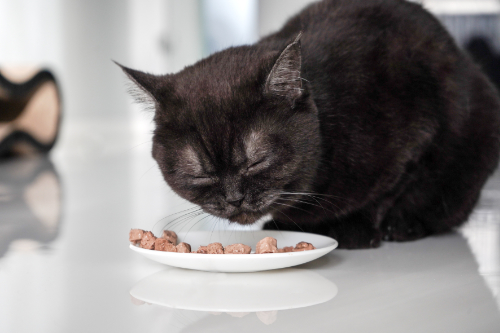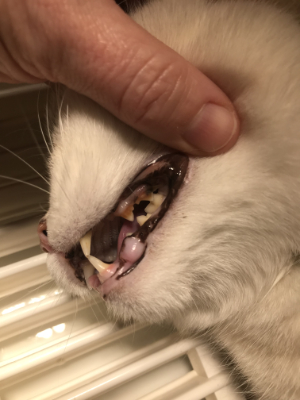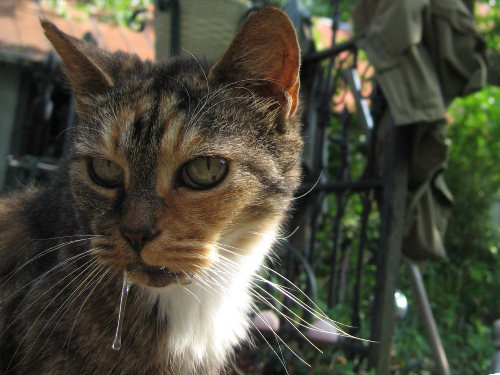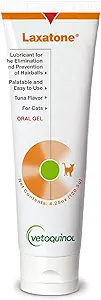How can you tell if your cat is having trouble swallowing?
A cat that is having trouble swallowing food or drink is usually seen sitting helplessly by its bowls. After all, he is hungry, but he can’t eat well. The fact that your cat is having trouble swallowing should not be confused with the fact that your cat does not want to eat because it is nauseous. It does have an appetite if your cat is having trouble swallowing. But for some reason it is difficult for him to swallow the food or his drink.
You can also see many different other symptoms with this. For example, that he picks up food, but then drops it again. Or that he throws the food from one side of his mouth to the other. drooling. Or even making visibly difficult movements while swallowing. It is of course very annoying for your cat is having trouble swallowing. So something needs to be done about that.

Causes of your cat is having trouble swallowing
Dental pain
In the vast majority of cases, a cat is having trouble swallowing because it experiences pain while swallowing food. But sometimes also while drinking. You usually see that a cat is having trouble swallowing, especially during eating. The pain can come from the teeth and molars or from the throat. It is therefore best to put your cat on a table or other surface and have a housemate hold your cat. You can then judge his teeth yourself.
The teeth should be nice and white and have no brown spots. Do they have this? Then this is probably tartar. This tartar can cause gingivitis. The gums are not beautiful light pink, as they should be, but dark red and often purulent. In this case, the teeth may even have become loose. So take a good look at that by pushing against the teeth. Of course they shouldn’t be able to move. Do you see very red gums in a certain spot? Then this is probably the cause of your cat is having trouble swallowing.
In young cats, the condition “juvenile gingivitis” also occurs. Better known as gingivitis-stomatitis complex. This creates a pretty intense form of inflamed gums in this young cat. This usually occurs just after the adult teeth have come through. It is believed to be some sort of allergic reaction to tooth enamel. You need a vet to treat this. And keep in mind that usually several visits are necessary. But this extreme form of gum disease is a very good reason for your cat is having trouble swallowing.
Pain in his throat
Don’t you see anything strange about the teeth? Then open your cat’s mouth slightly. To do this, place one hand on your cat’s forehead and then use your thumb and forefinger to grasp your cat’s upper jaw, just behind its large fangs. Then turn his nose just a little towards the ceiling. With your other hand you can then push the lower jaw down with your finger at the level of the front teeth. His mouth should open now. Don’t open it too far, because your cat won’t like that and then he’ll struggle and you won’t be able to see anything. Just open it up a little bit and look down his throat.
Particularly at the back of his throat it could look very red and inflamed. So you have to judge that. Does it look red and irritated? Then that is the cause why your cat is having trouble swallowing.

Blockage of the esophagus
Have you seen any abnormalities of the teeth and throat? Then your cat may have something stuck in its esophagus. This is not very common as cats generally do not pick up and swallow objects very often. But a hairball can get stuck in his esophagus. In that case you often see that they try to swallow, but that your cat is having trouble swallowing. You usually see him drooling a lot. However, he will then chew normally and without pain. In some cases, they also rub their throats.
Isn’t your cat too impressed and does it not hurt his teeth, molars or throat? Then you can try if your cat has less trouble swallowing if you give your cat an anti-hairball paste. A very good powerful remedy for this is lax-a-past. You must then put 2.5 cm of paste in your cat’s mouth once a day. And you do that for 3 days. Can’t get it in his mouth? Just smear it on his front feet. There is a good chance that he will wash it off himself and swallow it (with difficulty of course).
Tumors of the tongue
In old age, cats have more problems with their health. One such problem is tumors under the tongue. If the tumors under your cat’s tongue get bigger, the tongue can no longer be used properly. Your cat than is having trouble swallowing. This is quite easy to determine by yourself, provided your cat is willing to let you examine its tongue. You then have to push the tongue slightly to the side at the base of the tongue with your finger. In the case of a tumour, you will see lumps in that spot. They shouldn’t be there. Hopefully your cat will allow the examination well and you will not see anything strange under his tongue. You do see lumps? Then there is a good chance that this is the cause why your cat is having trouble swallowing.
Neurological problems
In rare cases, a cat is having trouble swallowing due to a problem with the nerve that controls the esophagus. We mainly see this in cats younger than 6 months old. In this case, the esophagus is unable to transport food from the throat to the stomach. The food then gets stuck in the esophagus and is usually expelled again within a short time after eating. In general, this young cat is already a bit behind in growth from an early age and you see a clear lag compared to peers.

When should you see your vet?
If your cat expresses pain while eating, or you have discovered bad teeth, it is wise to contact your vet. Also if you suspect that there may be a neurological problem or a tumor under the tongue, it is best to see your vet as soon as possible to have the problem diagnosed.
If you think your cat may have a hairball stuck, you can administer the lax-a-past treatment. However, your cat should not look too sick or miserable. After 3 days of lax-a-past, your cat should no longer have trouble swallowing. And at all times your cat should get a little (preferably half of its normal) meal. Otherwise he will get a fatty liver disease and may die. Are you in doubt? Then it is best to take your cat that is having trouble swallowing to your vet.

